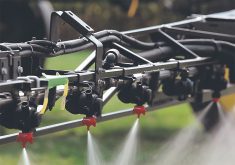The federal government is estimating that Agriculture Canada spending will fall by $418.6 million this year as the department’s contribution to deficit reduction.
According to spending estimates tabled in parliament, the departmental budget will drop 14 percent to $2.571 billion.
However, it is not a simple story of program cuts.
The totals represent savings from temporary programs that are expiring, presumptions of reduced investments in business risk management programs and bookkeeping changes that make it look like a funding increase for the Canadian Food Inspection Agency is bigger than it really is.
Read Also

No special crop fireworks expected
farmers should not expect fireworks in the special crops market due to ample supplies.
The government will also slash spending for Western Economic Diversification by $222.8 million, a 54 percent cut from spending in this fiscal year.
It is part of the government’s promise to cut spending in the fiscal year beginning April 1 by $10 billion to reflect the end of the two-year economic stimulus package and to reduce Canada’s record deficit.
Liberal agriculture critic Wayne Easter attacked the cuts as a betrayal of Canadian farmers by a government whose slogan is “putting farmers first.”
He said the Conservatives are trying to balance the books “on the backs of farmers,” a charge thrown at the Liberal government in 1995 after a deficit cutting budget took more than $1 billion out of agriculture spending. Easter was part of that government.
“This should end any notion within the farm community that the (Stephen) Harper government was ever sincere about putting farmers first,” Easter said.
“Agriculture minister Gerry Ritz and his boss Stephen Harper are making policy decisions that are deliberately cutting farm support programs.”
Agriculture minister Gerry Ritz said Easter’s criticisms are off the mark.
“The estimates are exactly that, an estimate,” he said by e-mail.
“Our business risk management programs are statutory and will continue to be there for farmers, just like they were there for livestock and grain producers across the West this year because of drought and flood. Unlike the Liberals, who cut agricultural funding, we’ve increased funding on research by almost 40 percent since 2006.”
The projected departmental spending cuts were unveiled the same week that Agriculture Canada projected a dramatic decline in realized net farm income in 2011 after what the department said was a record year in 2010.
The department expects that realized net farm income (gross receipts minus costs and depreciation) will fall 38 percent nationally, 69 percent in Manitoba and 66 percent in Saskatchewan.
In British Columbia, realized net farm income is projected at minus $165 million, the third consecutive year of losses.
Easter said the dire farm income forecast makes the forecast spending cut all the more damaging.
Canadian Federation of Agriculture president Ron Bonnett said the Agriculture Canada outlook is a mixed picture for farmers. It projects continued strong commodity prices but also rising costs that will negate much of the benefit of higher prices.
“It really is a good news, bad news thing,” he said. “It is important that our programs are properly funded.”
The government said more than half the departmental savings will come from programs that were scheduled to end.
Almost $50 million will be saved from reductions to the subsidy program for building infrastructure in
•The Department of Agriculture Act was approved May 22, 1868, creating Agriculture Canada. Today, Agriculture Canada is one of the federal government’s largest and most decentralized departments, employing the equivalent of 6,280 people in offices and research centres across the country.
•For more than 40 years, the department’s head offices in Ottawa were in the Sir John Carling building, named after an 1890s agriculture minister and famed beer maker. When the Carling building was condemned several years ago, head offices moved west to Nortel’s sprawling former offices. The building remains unnamed.
•Spending estimates must be tabled in parliament before April 1. The department tries to predict demand for statutory business risk management programs – these are programs that must pay out what is owed during the year no matter what the estimated budget might be.
•Federal spending estimates are just part of the picture. Since agriculture is a shared federal-provincial jurisdiction, provinces pay 40 percent of many programs while federal spending picks up the other 60 percent.
the biofuel industry, while the end of a pork industry transition program will save $39.3 million.
The end of a two-year program to upgrade federal labs will save almost $20 million.
The spending estimates also include an assumption that federal payments into the AgriInvest program will fall by more than $16 million.
The department is making no assumptions about AgriRecovery payments this year because disasters cannot be predicted. However, it paid more than $54 million last year and is counting that much as savings this year because it isn’t planning to spend it. The government says it will increase spending in the AgriFlexibility program by almost $50 million in 2011-12.
It will also spend $20 million more on a program to help packers cope with higher costs of specified risk material removal.
Meanwhile, Western Economic Diversification minister Lynne Yelich told the House of Commons a 54 percent cut in its budget for 2011-12 reflects the fact that many two-year job creation programs under the economic stimulus program are ending.














